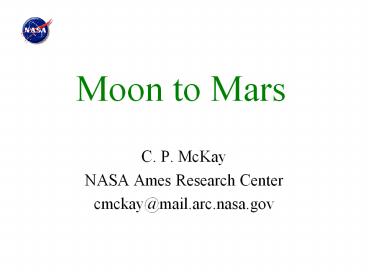Moon to Mars - PowerPoint PPT Presentation
Title:
Moon to Mars
Description:
Advantages of Lunar Precursor Mission ... terrain-related landing hazards (flat ... Suggested landing site is Oceanus Procellarum because a) meets selection ... – PowerPoint PPT presentation
Number of Views:70
Avg rating:3.0/5.0
Title: Moon to Mars
1
Moon to Mars
- C. P. McKay
- NASA Ames Research Center
- cmckay_at_mail.arc.nasa.gov
2
(No Transcript)
3
Greenhouses at a Mars Base 2025
4
When we go we will take plants with us. In
fact, well send them first.
5
Near-term missions
Using the martian soil and atmosphere for a plant
growth module
6
Life to Mars
- An organism-level test of soil biohazard,
environment, radiation, and martian gravity. - A technical and programmatic basis for advanced
plant-based life support systems. - Provides a wonderful opportunity for public
involvement (FTD Flowers to Mars). - Symbolic as first organism to grow, live, and die
on another world. - Helps diffuse back contamination issues for
sample return and human missions. - Biological precursor to human exploration.
- Consistent with planetary protection with no
inadvertent forward contamination of Mars.
7
Mars Exploration Program Advisory Group
- GOAL IV PREPARE FOR HUMAN EXPLORATION
- B. Objective Conduct in-situ engineering science
demonstrations (investigations listed in priority
order) - 7. Investigation Demonstrate plant growth in the
Martian environment. Demonstrate the ability of
the Martian environment (soil, solar flux,
radiation, etc.) to support life, such as plant
growth, to support future human missions.
Validation requires in-situ measurements and
process verification. http//mepag.jpl.nasa.gov/
8
Do it on the Moon first
- Partial gravity
- Radiation
- Planetary protection
9
Mission Concept
- Lunar plant growth module mission as a precursor
for Mars. - - Step towards Martian greenhouses for human
exploration.
Moon
Mars
10
Advantages of Lunar Precursor Mission
Close proximity to Earth 3 days (Moon)
vs 6 months (Mars) Easier landing fewer
unknown design variables, i.e. no atmosphere
Continuous communication during mission always
on lunar nearside Technology demonstration of
plant growth chambers, engineering systems
Demonstrate capability to comply with planetary
protection guidelines before landing on prime
astrobiological target of Mars
11
Landing Sites
Requirements Nearside of Moon for continuous
line-of-sight communication with Earth
Minimal terrain-related landing hazards (flat
surface with low slope, minimal rocks and
boulders, sufficient regolith coverage if using
lunar soil) Land on terminator to allow for
maximum mission lifetime (limited by sunlight
availability)
Suggested landing site is Oceanus Procellarum
because a) meets selection criteria and b)
previous in situ studies from Luna 9, Luna 13,
Apollo 12, Surveyor 3.
12
Lander Operations Timeline
HIGH NOON Day 7
DAWN Day 1
DUSK Day 15
13
Follow-On Missions
Lunar Plant Growth Module
Martian Plant Growth Module
Lunar Greenhouses
Martian Greenhouses
14
Fly me to the moon
15
(No Transcript)
16
(No Transcript)
17
(No Transcript)
18
(No Transcript)
19
(No Transcript)
20
(No Transcript)
21
(No Transcript)
22
(No Transcript)
23
(No Transcript)
24
(No Transcript)
25
(No Transcript)
26
The Antarctica Model
Fifty years of continuous operations, 1-15 month
tours. Three permanent bases with temporary field
camps. Dec 1956 Bases established, IGY Cold
War competition. Science exploration was
rationale, NSF assumed responsibility for science
in 19XX. 1970s, 1980s US Antarctic research
program operated as a part of foreign policy
military preparedness for cold weather
operations. 1990s Cold War ends, military
activities in USARP reduced. 2000 Helicopter
transport provided by private sector. 2005
Civilian science (NSF) managed program entirely.
Contractor operation of base (Ratheon Polar
Services) Air Force provides transport to
Antarctica, Coast Guard provides ice
breaker. 2006 NSF directed to assume operation
of ice breakers.
27
Applying the Antarctic Model to the Moon
2018 NASA establishes scientific research base
on Moon. 2023 Base declared operational.
Geological science activities become part of NSF.
NASA focuses on Mars (and beyond). NASA provides
transportation to and from Moon. 2030 Private
sector provides transport to and from Moon. NASA
is working on Mars.































